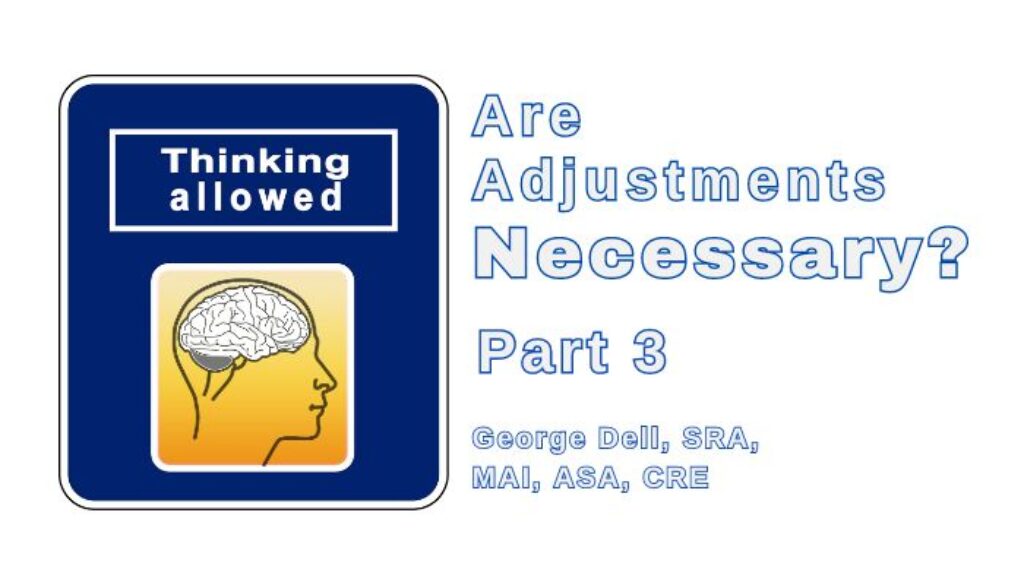“I never make adjustments,” said the MAI who first trained me. He was a top litigation appraiser. He explained that if he made an adjustment he had no way to explain how he got the number when cross-examined by the opposing attorney. Instead, he used what is called ‘qualitative analysis.’
The Appraisal of Real Estate (Appraisal Institute, 14th ed.) says: “Qualitative analysis techniques may also be applied for elements of comparison for which quantitative adjustments cannot be developed.” Hmmm. So sometimes a number adjustment can not be developed. Wow!
It goes on to say (comparing the three approaches), that there is a gradation of intensity of adjustments: ranging from “no adjustments” to the method of highest intensity: “adjustments via paired sales analysis.” (ARE, 15th ed., p.78).
USPAP says:
[ The word “adjustment” is not found in the Appraisal Foundation standards. ]
However, AF Advisory Opinions state that any adjustments made should be “appropriate.” Of course.
A dictionary definition of “adjust” is: “alter or move (something) slightly in order to achieve the desired fit, appearance, or result.”
The dictionary definition seems to fit the basic premise of legacy practice: “make an adjustment, then find a way to support it.”
Evidence Based Valuation (EBV)© SAYS: All adjustments are uncertain. There are four types:
- Mathematically calculated adjustments, such as for market conditions (time). These have variation on exact numbers, but are highly reliable, given data set variation. (The selection is critical.)
- Probabilistically estimated adjustments, where each data point has variation. These provide no definite result, but may provide a range (or distribution) of likely value. (The selection is critical.)
- Probabilistically biased results, where some bias is expected, but the direction of the bias may itself be estimated. The result may be useful, even though biased.
- Fully uncertain Uncertain uncertainty. These occur where there is no helpful data. Such an adjustment relies on the knowledge and judgment of the expert – the appraiser.
Note that no adjustment is exact. What matters is — how sure, and how true, is the result.
It’s a fiction that adjustments can be exactly extracted “from the market.”
EBV is Data Science for asset assay. Data Science explicitly recognizes the need for the subject-matter expert. Valuation by a competent appraiser.
EBV applies the complete Competitive Market Segment (CMS©) data, as available. The high reliability of time adjustments (as above) expands the availability and the usefulness of prior data. This, in turn, makes other adjustments more reliable.
Where data is truly sparse, the reasoning process of EBV and price indexing often saves the day.
In applying EBV process, we have found that adjustments are almost unnecessary! Some adjustments, such as for location and transaction elements (such as financing and concessions) are appropriate.
But we find that some other elements are “personal preference” based. These are highly uncertain, and best presented with qualitative vision, rather than through fictional quantitative exactness.
Go to valuemetrics.info now, to prepare for today’s future.

February 28, 2024 @ 5:38 am
Thank you for this helpful article series. I’d really like to read parts 1 & 2. May I please ask for the specific links to Are Adjustments Necessary Parts 1 and 2? It would be helpful in a Part 3 article for the links to Parts 1 & 2 be listed inside the Part 3 article. Any time there’s a Part 2 or Part 3 article series, it would be helpful if the links initiating the article series, say Part 1, were in articles Part 2 or Part 3 so we can go back and follow the series. When I visit the category https://georgedell.com/category/adjustments/, there are about 20+ helpful articles, but none showing Are Adjustments Necessary Part 1 or Part 2. Thank you so much for your help and dedication to helping Appraisers!
February 28, 2024 @ 7:47 am
George, have you approached the Appraisal Institute to teach your EBV? And if so, what was the response? Having just been a part of the AI’s open post-board meeting, it seems they may be willing to entertain EBV.
February 29, 2024 @ 8:10 pm
Good point Tom Stowe. There is no doubt they are well aware of George Dell’s curriculum. It would seem in light of all the current issues, they will be pushing ahead to further embrace this type of auditable analysis.
March 4, 2024 @ 8:51 am
I just hate to make things up. In commercial appraisal, some clients and reviewers insist on quantitative adjustments: percent or per square foot. I’ve read reports with those kind of adjustments, and when someone makes a 20% adjustment for, say, location, I wonder, Why not 10%? or 30%? The adjustment algorithm is usually inherently circular, not based on any external facts, and prone to manipulation. What’s the point of adjustment grids? To create a range of adjusted values that is narrower than the unadjusted range. How do you know you have the right adjustments? When the range of adjusted values is narrower than the unadjusted range. QED. This is circular and self-justifying.